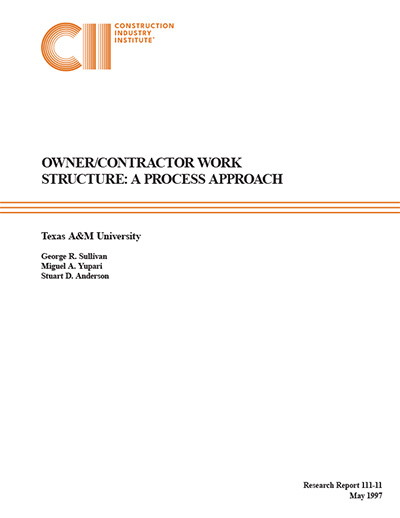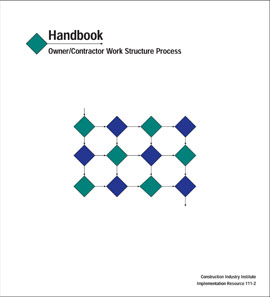
Owner/Contractor Work Structure: A Preview
The shifting of many engineering resources from owners to contractors for project planning and execution has created a problem in today’s construction industry: corporate-level and project-level work structures are increasingly difficult to organize. “Core competencies,” or essential areas of expertise, need to be identified and appropriate responsibilities assigned so that corporations have a competitive advantage in the global market.
The solution to the problem of work structures can be found in CII Implementation Resource 111-2, Owner/Contractor Work Process Handbook. A summary of the research that led to that publication is presented here. The work process was developed by the CII Owner/Contractor Work Structure Research Team, which was chartered to find a method that companies can use to create work structures that lead to project success. The research team believes that the process, which has been developed for immediate use, will enable organizations to meet both corporate and project objectives through aligned owner/contractor work structures.
The work process provides a systematic approach for determining the competencies of the owner and contractor organizations. Knowing where each core competency is in the working relationship will allow decisions to be made about how to organize strategically. The process is flexible, and thus can be used by different companies and in different situations. It also provides a method for creating both internal and external alignment.
This summary provides an overview of the work structure problem in the industry that led CII to seek solutions. To help one understand the work structure models, key definitions and frameworks for both corporate and project structures are presented here, but the reader is encouraged to use the Owner/Contractor Work Process Handbook for implementing the actual process.
Thirty recommended project competencies were identified to support the capital projects delivery process. Examples include:
- Conceptual Cost Estimating: Preparation of estimates at various stages of scope development for purposes of project option selection
- Constructability: Incorporating construction knowledge and experience into project development and execution
- Construction: Installation of permanent facility equipment and materials including all support required to do so
- Construction Management: Management oversight of field construction operations and startup
Perceptions of business unit managers, operations managers, technical managers, and project managers are:
- Most downsizing is driven by attempts to reduced fixed costs.
- Reengineering of entire organizations has occurred.
- Loss of expertise has occurred through retirements.
- Owners have fewer experienced project managers.
- Contractors are not adding skills necessary for outsourcing.
- Contractor responsibilities are increasing, but staff size is not keeping pace.
- Owner representatives today often lack decision-making authority, resulting in poorly informed decisions by owners, with varying effectiveness.



